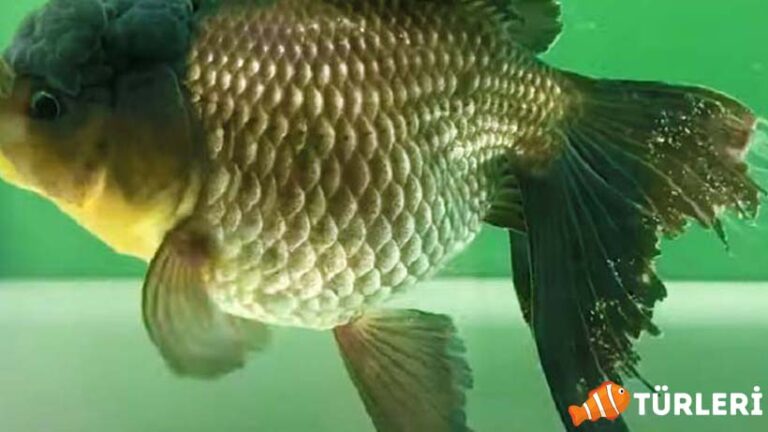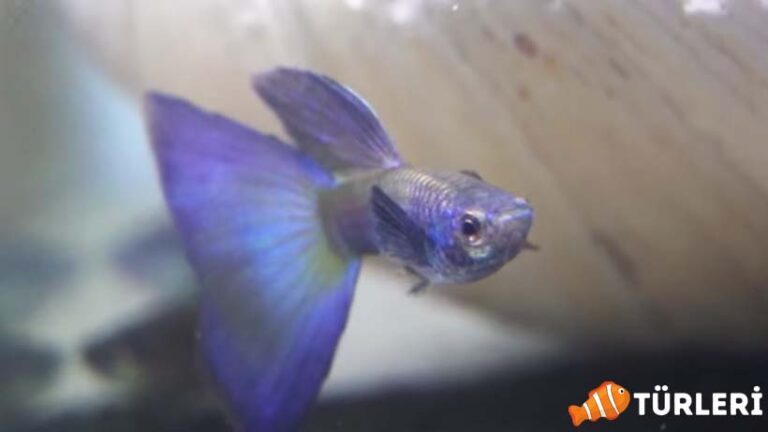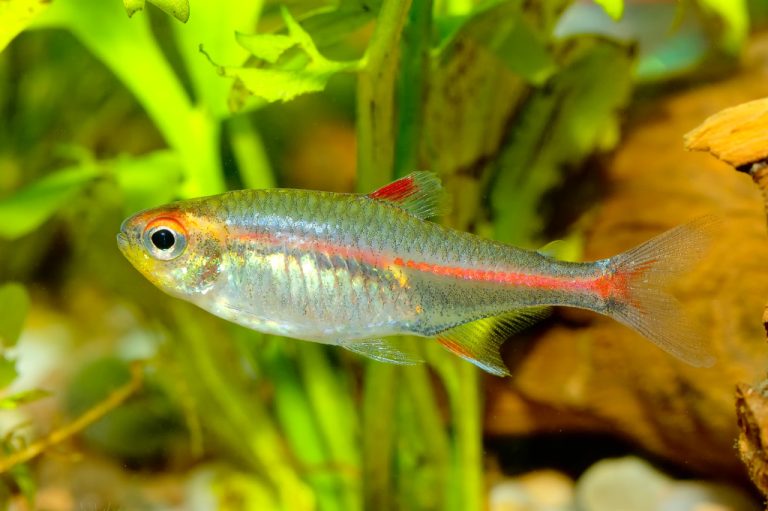Bristlenose Pleco Fish Care, Feeding, and More
Bristlenose Pleco, or scientifically known as the Ancistrus genus, is popular in freshwater aquariums. They are particularly known for their striking appearance and their algae-eating habits.
Bristlenose Pleco Fish Species Summary:
| Scientific Name: | Ancistrus sp. |
| Origin: | Freshwater sources of South America |
| Diet: | Herbivore (mostly feeds on algae but may also need protein supplements) |
| Behavior: | Peaceful |
| Behavior Towards Their Own Species: | Can be territorial, so sufficient hiding spots should be provided. |
| Swimming Zone: | Bottom |
| Water Temperature: | 22 – 28 °C |
| Water Hardness: | 6 – 15 GH |
| pH Level: | 6.5 – 7.4 |
| Minimum Aquarium Volume: | 100 Liters (can vary depending on the number of individuals) |
| Adult Size: | 10 – 15 cm (can vary among species) |
| Reproduction: | They lay eggs and require nesting areas. |
| Lifespan: | 5 – 10 years (with proper care) |
| Care: | Moderate, requires regular aquarium cleaning and sufficient hiding spaces. |
Care:

Aquarium Size:
- Why 60 Liters?: The Bristlenose Pleco is an energetic fish that requires ample space to move around. A 60-liter aquarium allows these fish to swim freely and graze on algae. Circulation and Movement: The width of the aquarium allows the Pleco to turn and move freely. Moreover, maintaining water quality is easier in a larger aquarium.
- Water Temperature: Range 22-28°C: This temperature range is prevalent in the tropical waters of South America, the natural habitat of the Bristlenose Pleco. At this temperature, the fish remain active, healthy, and unstressed.
- Temperature Fluctuations: Constant temperature changes can increase the fish’s stress. Hence, maintaining a stable temperature in the aquarium is crucial.
PH:
- Why 6.5-7.5?: The Bristlenose Pleco thrives best in this pH range. The waters in their natural habitats fall within this pH range.
- Significance of PH: PH indicates the acidity or alkalinity of the water. The Bristlenose Pleco has the best feeding, growth, and reproductive capabilities within this specified range.
Decoration:
- Caves and Hiding Spots: Bristlenose Plecos naturally hide among rocks and roots in their natural habitats. Providing cave-like structures in the aquarium offers them a safe space, reducing their stress.
- Sand and Fine Gravel: These fish prefer a soft substrate where they can lay and protect their eggs. Such substrates also facilitate the fish to graze the surface and consume algae. Plants: Live plants provide more surfaces for the Bristlenose Pleco to graze for algae. They also improve water quality, contributing to the overall health of the fish.
Decoration is not just for aesthetic purposes but is also vital to encourage the natural behaviors of the Bristlenose Pleco and provide them with a comfortable living environment. Ensuring these recommended conditions in your aquarium will result in a healthier, more active, and happier Bristlenose Pleco.
Feeding:

Algae:
- Natural Algae Formation: The primary food source for the Bristlenose Pleco is algae. Natural algae formation occurs in the aquarium based on the balance of light and nutrients. This algae provides the essential nutrients the Pleco needs to remain healthy.
- Importance of Algae: Algae supply the essential vitamins and minerals for Pleco. Moreover, the habit of algae grazing encourages the natural behavior of this fish.
Algae Tablets and Special Pleco Foods:
- Supplementary Food: When there isn’t enough natural algae formation in the aquarium, algae tablets and specialized pleco foods are an excellent option to address this deficiency. These feeds provide the essential nutrients the fish requires.
- Feeding Frequency: Since Bristlenose Plecos are generally active at night, it’s best to feed them in the evenings.
Vegetables:
- Dietary Diversity: Boiled vegetables like zucchini, spinach, and peas play a significant role in the Bristlenose Pleco’s diet. Vegetables provide the fish with fiber, vitamins, and minerals.
- Preparation: Boiling the vegetables softens them, making them easier for the Pleco to consume. You can leave the vegetables in the aquarium for several hours or a day and then remove the leftovers.
Protein-rich Foods:
- Protein Sources: Protein sources like sinking dried foods, harmless live feeds, or frozen feeds are an important supplement in the Bristlenose Pleco’s diet.
- Importance of Protein: Protein is essential for muscle growth, repair, and the overall health of the fish. However, since the primary diet of the Bristlenose Pleco is plant material, it’s best to give protein feeds only a few times a week.
Feeding is a critical factor directly affecting the health of the Bristlenose Pleco. A regular and balanced diet ensures that this fish remains healthy, energetic, and long-lived. By considering the natural habits and dietary needs of the Bristlenose Pleco, you can provide the most suitable feeding regime for them.
Reproduction:

Cave Preference:
- Importance of the Cave: Bristlenose Plecos prefer a dark, sheltered cave to lay their eggs. This behavior mirrors their habits in their natural habitat.
- Preparation of the Cave: In the aquarium, by creating a suitable cave for spawning, you can encourage the reproduction of Bristlenose Plecos. These caves can be formed using rock formations or ceramic tubes.
Role of the Male:
- Protection of the Eggs: After the eggs are laid, the male individual settles over them and protects them from potential threats.
- Aeration: The male also uses his fins to move the water around the eggs, ensuring a continuous supply of fresh water. This provides oxygen to the eggs and prevents the formation of fungus.
Incubation Period:
- Between 5-10 Days: The incubation period for the eggs typically ranges between 5-10 days, but this can vary depending on the water temperature, pH level, and other environmental factors.
- Baby Plecos: At the end of the incubation period, baby Plecos hatch from the eggs. Initially, these fry are very small and feed on their egg sacs for the first few days after hatching.
Fry Care:
- Feeding: Once the egg sac is consumed, the baby Plecos need to be fed with specially formulated algae-based feeds and microfeeds.
- Protection: It’s essential to protect baby Plecos in the aquarium from larger fish or other potential threats. This can be achieved by raising them in a separate fry tank or creating a separate section in the aquarium away from the larger fish.
Successfully breeding Bristlenose Plecos can be accomplished with the provision of the right conditions and proper care. By simulating their natural habitat in the aquarium environment, you can ensure a healthy reproductive process for these fish.
Compatible Species:
- Tetra: Tetras are generally fast and energetic fish. Thanks to the Bristlenose Pleco’s slow movements and unobtrusive nature, conflicts with Tetras do not arise. Also, the Tetras’ tendency to swim in the upper parts of the water column harmonizes with the Bristlenose Pleco staying in the lower regions.
- Guppy, Molly, and Platy: These livebearing fish generally have a calm demeanor and coexist peacefully in an aquarium. When kept with a Bristlenose Pleco, they create a safe environment for both parties.
- Corydoras: Corydoras fish exhibit a similar bottom-dwelling behavior. However, these two species are generally tolerant of each other. With adequate feeding and enough hiding spots, there should be no issues housing Bristlenose Plecos and Corydoras together.
- Cichlid Species: Peaceful cichlid species typically get along well with Bristlenose Plecos. However, when kept with aggressive cichlid species, especially without ample hiding places, they can pose a risk to the Bearded Pleco.
Points to Consider:
- Bottom Space Competition: Bristlenose Plecos may compete with other bottom-dwelling fish they share the substrate with. This becomes especially evident when there is not enough hiding space or food source.
- Other Pleco Species: Competition can arise among different Pleco species, especially for caves or hiding places. If you are keeping multiple species of Plecos in the same aquarium, ensure there’s sufficient hiding space for each individual.
- Aquarium Conditions: To house different fish species together, it’s essential to ensure that water parameters, temperature, pH, and other conditions are suitable for all fish.
Bristlenose Plecos can coexist successfully with a wide range of species in a broad freshwater community aquarium. However, it’s always crucial to consider each fish’s individual needs and behaviors to create a harmonious aquarium community.







